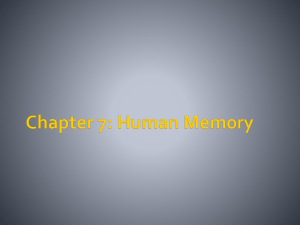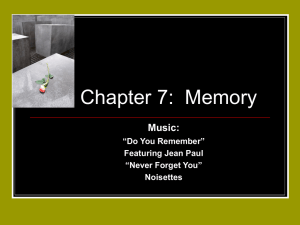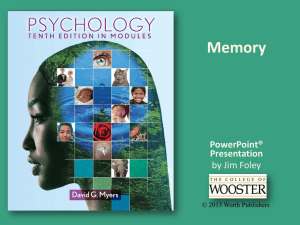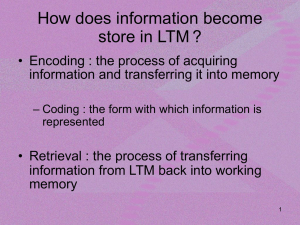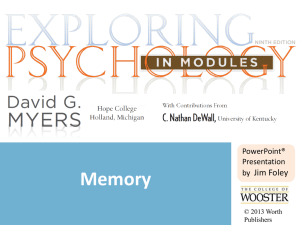Encoding & Storage
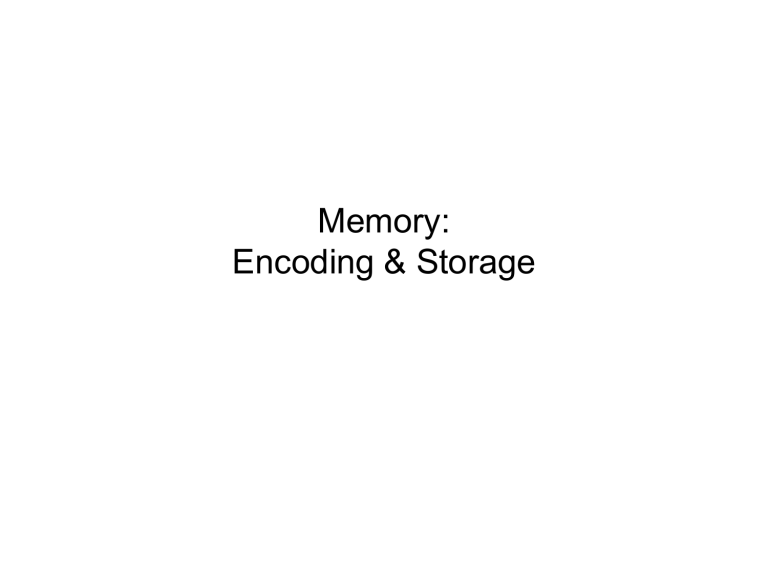
Memory:
Encoding & Storage
Information Processing
Atkinson-Schiffrin three-stage model of memory includes a) sensory memory , b) short-term memory and c) long-term memory .
Information Processing a) sensory memory -immediate, very brief recording of sensory information in the memory system
Information Processing b) short-term memory -activated memory that hold a few items briefly before it is stored or forgotten
Information Processing b) short-term memory -activated memory that hold a few items briefly before it is stored or forgotten
Information Processing c) long-term memory -relatively permanent and limitless storehouse of the memory system.
Includes knowledge, skills, and experiences.
Modifications to the Three-Stage
Model
1. Some information skips the first two stages and enters long-term memory automatically.
2. Since we cannot focus on all the sensory information received, we select information that is important to us and actively process it into our working memory .
Information Processing
What is special about working memory?
Working Memory Store
• What happens if you need to keep information in working memory longer than
30 seconds?
• To demonstrate, memorize the following phone number (presented one digit at a time):
Working Memory Store
8 5 7 9 1 6 3
Working Memory Store
• What is the number?
857-9163
• The number lasted in your working memory longer than 30 seconds
• So how were you able to remember the number?
Maintenance Rehearsal
• Mental or verbal repitition of information allows it to stay in your working memory longer than the usual 30 seconds
• What is the number? 857-9163
Encoding: Getting Information in
Encoding: Getting Information In
How We Encode
1. Some information (route to your school) is automatically processed.
2. However novel information (friend’s new cell-phone number) requires attention and effort .
Automatic Processing
Enormous amount of information is processed effortlessly by us, like:
1. Space: While reading a textbook you automatically encode place of a picture on a page.
2. Time: We unintentionally note the events that take place in a day.
3. Frequency: You effortlessly keep track of things that happened to you.
Effortful Processing
Novel information committed to memory requires effort, like learning a concept from a text. Such processing leads to durable and accessible memories.
Rehearsal
Effortful learning usually requires rehearsal or conscious repetition.
Ebbinghaus studied rehearsal by using nonsense syllables :
TUV YOF GEK XOZ
Hermann Ebbinghaus
(1850-1909)
Rehearsal
The more times the nonsense syllables were practiced on Day 1, the fewer repetitions were required to relearn them on Day 2.
Memory Effects
1. Next-in-line-Effect: When your recall is better for what other people say but poor for a person just before you in line.
2. Spacing Effect: We retain information better when our rehearsal is distributed over time.
3. Serial Position Effect: When your recall is better for first and last items, but poor for middle items on a list.
Serial Position Effect
1.
TUV
2.
ZOF
3.
GEK
4.
WAV
5.
XOZ
6.
TIK
7.
FUT
8.
WIB
9.
SAR
10. POZ
11. REY
12. GIJ
Better recall
Poor recall
Better recall
Memory Demo
Handout 27-1
What We Encode
1. Encoding by meaning
2. Encoding by images
3. Encoding by organization
Encoding Meaning
“Whale”
Q: Did the word begin with a capital letter?
Structural
Encoding
Q: Did the word rhyme with the word
“weight”?
Phonemic
Encoding
Q: Would the word fit in the sentence?
He met a __________ in the street.
Semantic
Encoding
Craik and Lockhart (1972)
Shallow
Intermediate
Deep
Results
Visual Encoding
Mental pictures (imagery) are a powerful aid to effortful processing, especially when combined with semantic encoding.
Showing adverse effects of meth use in a picture may be more powerful than simply talking about it.
Storage: Retaining Information
Sensory Memory
Working/Short-term
Memory
Long-Term Memory
Storing Memories in the
Brain
D é ja Vu means "I've experienced this before.
”
Cues from the current situation may unconsciously trigger retrieval of an earlier similar experience.
Retrieval Cues
Memories are held in storage by a web of associations. These associations are like anchors that help retrieve memory.
smell
Fire Truck water hose fire smoke heat truck red
Storage: Retaining
Information the heart of memory is storage.
Three stores of memory are :
Sensory
Memory
Working
Memory
Long-term
Memory
Encoding
Events
Encoding Retrieval
Retrieval
Sensory Memory
Events
Sensory
Memory
Working
Memory
Long-term
Memory
Encoding
Encoding Retrieval
Retrieval
Events
Sensory Memory
Iconic memory —few tenths of a second
Sensory
Memory
Echoic memory —3 or 4 seconds
Working Memory
Events
Sensory
Memory
Working
Memory
Long-term
Memory
Encoding
Encoding Retrieval
Retrieval
Long-Term Memory
Events
Sensory
Memory
Working
Memory
Long-term
Memory
Encoding
Encoding Retrieval
Retrieval
Long-Term Memory
Unlimited! Estimates on capacity range from 1000 billion to 1,000,000 billion bits of information.
Clark’s nutcracker can locate 6,000 caches of buried pine seeds during winter & spring.
Rajan Mahadevan recited 31, 811 digits of pi on July 4th, 1983
Hippocampus
≠
Cerebellum
Hippocampus – a neural center in the limbic system that processes explicit memories.
Cerebellum – a neural center in the hindbrain that processes implicit memories.
Explicit Memories
Explicit Memory refers to facts and experiences that one can consciously know and declare.
What is the capital of Kyirblahkyrstan?
Hippocampus
≠
Cerebellum
Hippocampus – a neural center in the limbic system that processes explicit memories.
Cerebellum – a neural center in the hindbrain that processes implicit memories.
Implicit Memories
Implicit memory involves learning an action, but the individual doesn ’ t know/declare what she knows.
Two Types of Long-Term Memory
Stress Hormones & Memory
Heightened emotions (stress related or otherwise) make for stronger memories.
Continued stress can disrupt memory.


